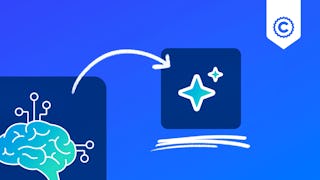PyTorch is one of the top 10 highest paid skills in tech (Indeed). As the use of PyTorch for neural networks rockets, professionals with PyTorch skills are in high demand. This course is ideal for AI engineers looking to gain job-ready skills in PyTorch that will catch the eye of an employer.

Saving $160 on access to 10,000+ programs is a holiday treat. Save now.


Introduction to Neural Networks and PyTorch
This course is part of multiple programs.

Instructor: Joseph Santarcangelo
93,695 already enrolled
Included with 
(1,875 reviews)
Recommended experience
What you'll learn
Job-ready PyTorch skills employers need in just 6 weeks
How to implement and train linear regression models from scratch using PyTorch’s functionalities
Key concepts of logistic regression and how to apply them to classification problems
How to handle data and train models using gradient descent for optimization
Skills you'll gain
Details to know

Add to your LinkedIn profile
See how employees at top companies are mastering in-demand skills

Build your subject-matter expertise
- Learn new concepts from industry experts
- Gain a foundational understanding of a subject or tool
- Develop job-relevant skills with hands-on projects
- Earn a shareable career certificate from IBM

There are 6 modules in this course
This module provides an overview of tensors and datasets. It will cover the appropriate methods to classify the type of data in a tensor and the type of tensor. You will learn the basics of 1D and 2-D tensors and the Numel method. Then you will learn to differentiate simple and partial derivatives. The module lists the different attributes that PyTorch uses in order to calculate a derivative. You will build a simple dataset class and object and a dataset for images. You will apply your learnings in labs and test your concepts in quizzes.
What's included
7 videos3 readings1 assignment6 app items3 plugins
This module describes linear regression. You will learn about classes, and how to build custom modules using nn.Modules to make predictions. Then you will explore the state_dict() method that returns a python dictionary. Then you will learn how to train the model, define a dataset and the noise assumption. You will further see how to minimize the cost and how to calculate loss using PyTorch. You will understand the Gradient Descent method and how to apply it on the cost function. You will learn to determine the bias and slope using the Gradient Descent method and define the cost surface. You will apply your learnings in labs and test your concepts in quizzes.
What's included
7 videos1 reading1 assignment3 app items2 plugins
This module covers implementing stochastic gradient descent using PyTorch’s data loader. Then you will explore batch processing techniques for efficient model training. You will compare Mini-Batch Gradient Descent and Stochastic Gradient Descent. Next, you will learn about Convergence Rate and using PyTorch’s optimization modules. Finally, you will learn the best practices for splitting data to ensure robust model evaluation and how hyperparameters are applied to train data. You will apply your learnings in labs and test your concepts in quizzes.
What's included
5 videos1 assignment4 app items1 plugin
In this module, you will learn to use the class linear to perform linear regression in multiple dimensions. In addition, you will learn about model parameters and how to calculate cost and perform gradient descent in PyTorch. You will learn to extend linear regression for multiple outputs. You will apply your learnings in labs and test your concepts in quizzes.
What's included
4 videos1 assignment4 app items
In this module, you will learn the fundamentals of linear classifiers and logistic regression. You will learn to use the nn.sequential model to build neural networks in PyTorch. You will implement logistic regression for prediction. The module also covers statistical concepts like Bernoulli Distribution and Maximum Likelihood Estimation underpinning logistic regression. In addition, you will understand and implement the cross entropy loss function. You will apply your learnings in labs and test your concepts in quizzes.
What's included
4 videos1 assignment3 app items
In this module, you will implement the final project applying all concepts learned. You will build a logistic regression model aimed at predicting the outcomes of League of Legends matches. Leveraging various in-game statistics, this project will utilize your knowledge of PyTorch, logistic regression, and data handling to create a robust predictive model.
What's included
2 readings1 peer review2 app items1 plugin
Earn a career certificate
Add this credential to your LinkedIn profile, resume, or CV. Share it on social media and in your performance review.
Instructor

Offered by
Explore more from Machine Learning
 Status: Free Trial
Status: Free TrialCoursera
 Status: Free Trial
Status: Free Trial Status: Free Trial
Status: Free Trial
Why people choose Coursera for their career




Learner reviews
1,875 reviews
- 5 stars
65.68%
- 4 stars
21.68%
- 3 stars
5.96%
- 2 stars
3.67%
- 1 star
2.98%
Showing 3 of 1875
Reviewed on Jul 12, 2020
Excellent Course. I love the way the course was presented. There were a lot of practical and visual examples explaining each module. It is highly recommended!
Reviewed on Apr 29, 2020
An extremely good course for anyone starting to build deep learning models. I am very satisfied at the end of this course as i was able to code models easily using pytorch. Definitely recomended!!
Reviewed on Mar 29, 2020
this course provides a very good and cohesive introduction to Neural Networks. I learned a lot during my journey and I recommend it for anyone interesting in the field.

Open new doors with Coursera Plus
Unlimited access to 10,000+ world-class courses, hands-on projects, and job-ready certificate programs - all included in your subscription
Advance your career with an online degree
Earn a degree from world-class universities - 100% online
Join over 3,400 global companies that choose Coursera for Business
Upskill your employees to excel in the digital economy
Frequently asked questions
To access the course materials, assignments and to earn a Certificate, you will need to purchase the Certificate experience when you enroll in a course. You can try a Free Trial instead, or apply for Financial Aid. The course may offer 'Full Course, No Certificate' instead. This option lets you see all course materials, submit required assessments, and get a final grade. This also means that you will not be able to purchase a Certificate experience.
When you enroll in the course, you get access to all of the courses in the Certificate, and you earn a certificate when you complete the work. Your electronic Certificate will be added to your Accomplishments page - from there, you can print your Certificate or add it to your LinkedIn profile.
More questions
Financial aid available,
¹ Some assignments in this course are AI-graded. For these assignments, your data will be used in accordance with Coursera's Privacy Notice.


